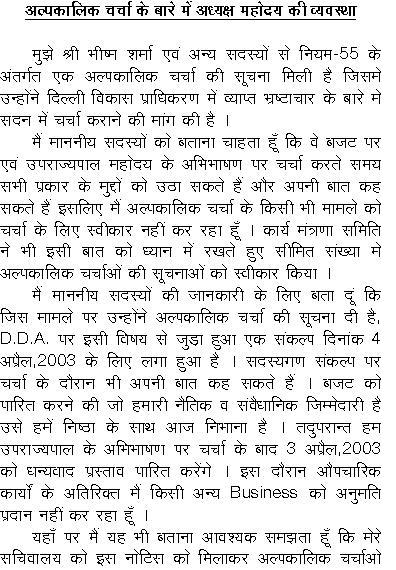
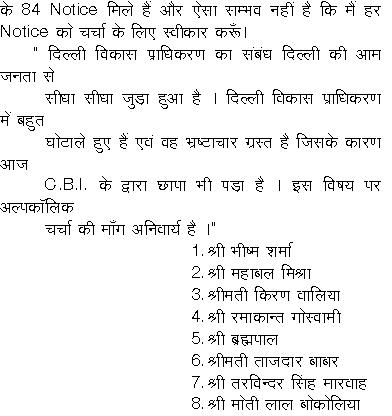
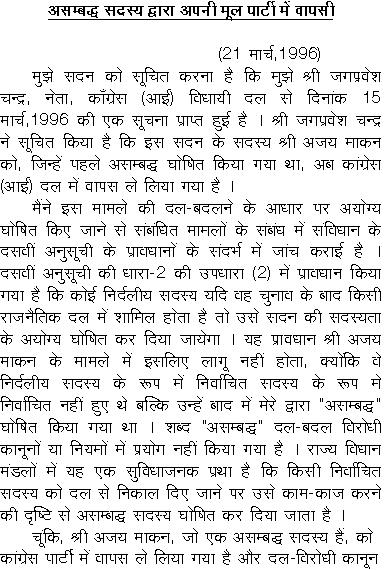
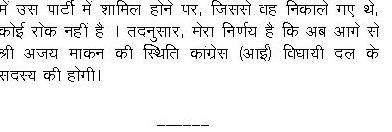
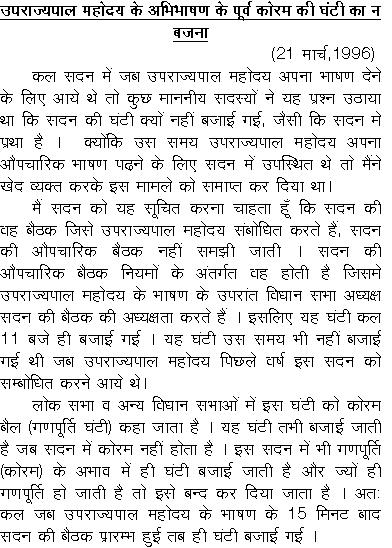
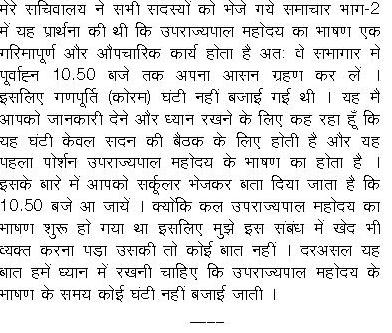
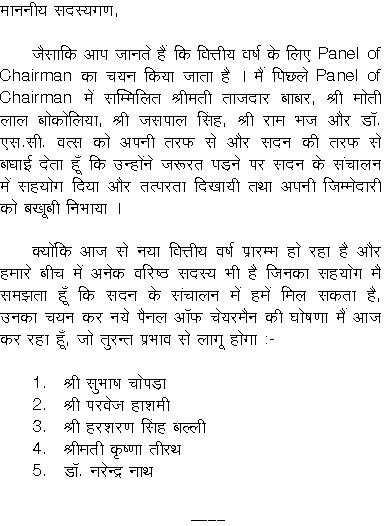
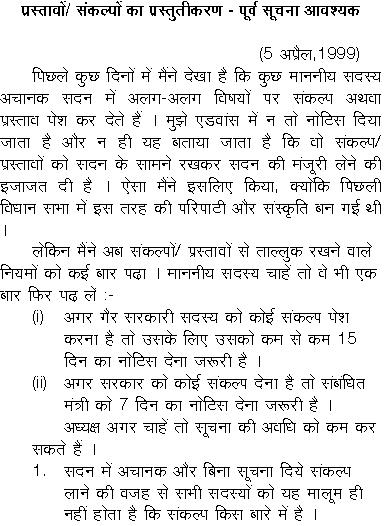
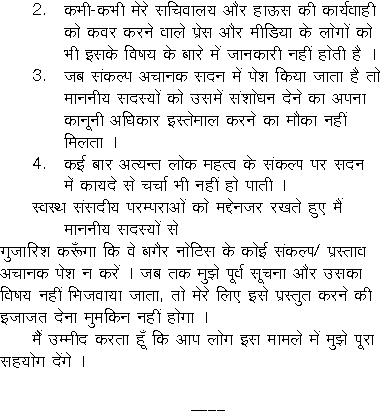
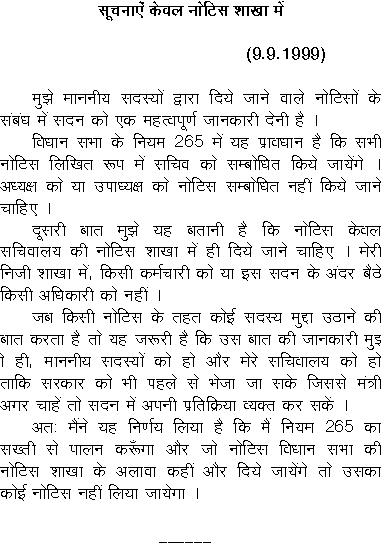
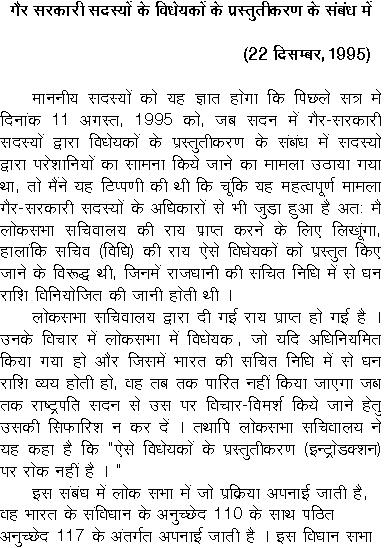
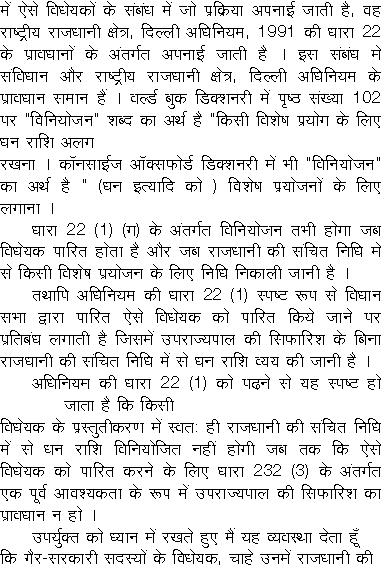

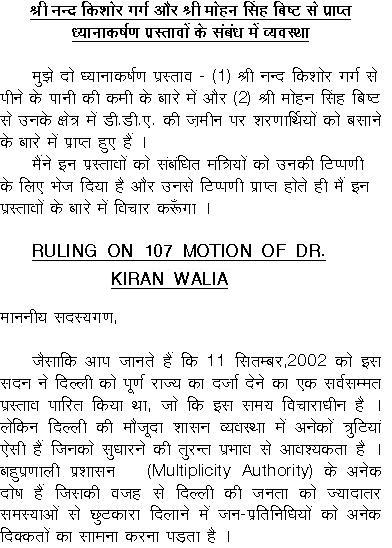
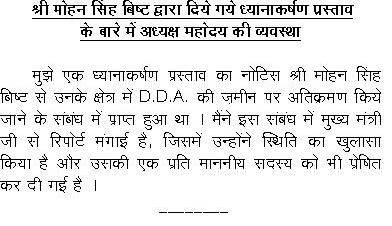
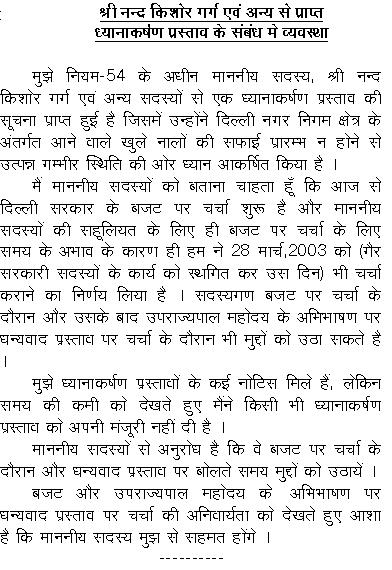
Observations made by the Chair ( Hon. Dy. Speaker) On 11th September,2002
- I have received notices of three Motions under Rule 107.
- The first Motion is from Chief Minister Smt. Shiela Dikshit wherein she has inter alia stated that the Ministry of Home Affairs, Govt. of India vide its letter dated 25 July,2002 and 29 August,2002 has communicated certain amendments on the definition of Government and in the Transaction of Business Rules. She has stated that these two unilateral orders are aimed at curtailing the powers of a duly elected popular Govt. and hence they should be immediately withdrawn by the Central Govt.
- The Motion is in order and I have admitted the same.
- The second Motion has been received from Dr. Jagdish Mukhi and his party colleagues. The Motion reads as under :-
- "This House resolves that Delhi be given full-fledged statehood and requests the Union Govt. to bring an appropriate legislation in this regard."
- The third Motion has been received from Dr. A.K. Walia and it reads as under :-
- "This House expresses its resolve that Govt. of NCT of Delhi be granted Statehood by bringing about major institutional and structural reforms based on broad consensus to empower the citizens of Delhi through their elected representatives to provide good city governance befitting the National Capital of our country."
- The Motions given by Dr. Mukhi and Dr. Walia are similar and on the same subject.
- The established Parliamentary procedure is that wherein notices of a Govt. Motion and Private Member's Motion are received on the same subject, the Govt. Motion is admitted.
- Hence, I have admitted the Motion given by the Minister of Urban Development, Dr. A.K.Walia which finds place in today's List of Business.
Observations made by the Chair ( Hon. Dy. Speaker) On 11th September, 2002
- There are two Motions listed in today's agenda. The subject matter of the Motions is somewhat inter related. I, therefore, propose that we may have combined discussion on both the Motions with a view to avoid repetitious speeches and to save the precious floor time.
- Both the Motions, however, would be moved separately.
- At the end of the discussion Hon'ble Chief Minister will reply to the debate and thereafter the Motions will be taken up for voting separately.
Amendment to the Motion
- In order to be admissible an amendment should be relevant and within the scope of the Motion to which it is proposed. It should not introduce new or foreign matter or widen the scope of Motion.
- The object of an amendment is either to modify a question before the House with a view to increasing its acceptability or to present to the House a different proposition as an alternative to the original question. An amendment modifies or substitutes only a part of the original Motion and does not change all the words of the question before the House though it may bring a different scheme before the House.
- As regards the form of amendment, it can be divided into three classes :-
- Amendments for omission of certain words, figures or marks;
- Amendments for substitution of certain words, figures or marks;
- Amendments for addition or insertion of certain words, figures and marks.
Sources : Mays Parliamentary Practices, Page 395
Kaul & Shakhders Practice & Procedure in Parliament, Page 664-666.
Government Motion Gets Precedence
- Where notices of a Government Motion and Private Members motion are received on the same subject, the Govt. Motion is admitted and Private Members Motion is disallowed.
- If a Private Members Motion is admitted and thereafter notice of Government Motion on the same subject is received, Government Motion is also admitted.
- If it is decided to have discussion on that subject by way of a Motion, Government Motion gets precedence over Private Members Motion.
- Since Government Motion was received first and was admitted, Dr. Mukhi's (who is a Private Member) his motion has, therefore, been disallowed as per procedure.
___________________________________________________________________________
Sources: Kaul & Shakhders, Practice & Procedure in Parliament, Page 674-675.
Two Motions on the Same day
- There is no embargo in our rules that two Motions cannot come on the same day. The embargo is only in respect of Call Attention Motions and the rule says that not more than one matter shall be raised at the same sitting.
- In Lok Sabha on 10th May,1993 the following two motions were introduced in the names of five members in order of priority in the list of business :-
- Motion for presenting address to the President of India under Article 124(4) of the Constitution regarding removal of a judge.
- Motion for considering a report of the Inquiry Committee constituted to investigate into the grounds on which the removal of Justice V. Ramaswamy, Judge of the Supreme Court of India, was prayed for.
- Sh. Somnath Chaterjee, who was first in priority moved both the motions which were discussed together
SOURCES : Lok Sabha debate 10th May,1993
Kaul & Shakhders, Practice and Procedure in Parliament, Page 660



